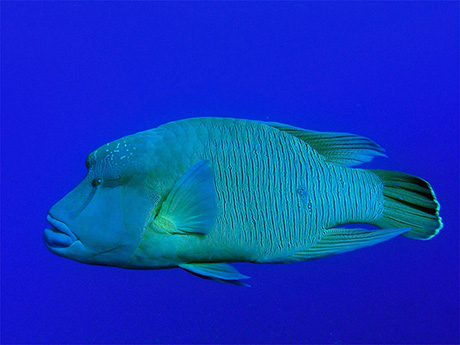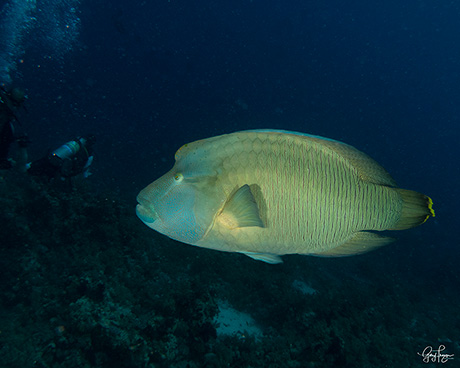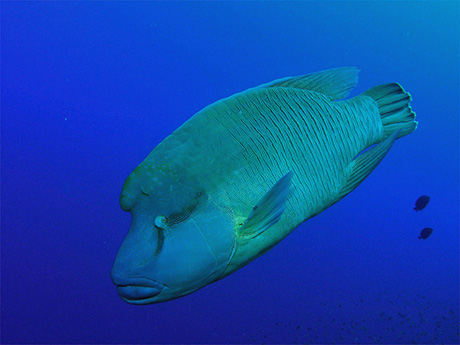

9 January 2022
The Humphead Wrasse is found throughout the warm waters of the Red Sea, the Indian and Pacific Oceans. An extremely large fish, it grows to over 2 m and can weigh over 190 kg (420 lb or 30 stone)! It has several names, depending on where in the world you are, including Napoleon and Maori Wrasse.

Living between 1 and 60 m down, you can easily identify the fish by its large size and, in the case of a male, the prominent bulge on its forehead. Usually solitary, it feeds primarily on invertebrates and will even take toxic animals like crown-of-thorns starfish, boxfish or sea hares.
Like others in the wrasse family, the Humphead Wrasse doesn't usually move its tail when swimming but flaps its pectoral fins. The species can live for at least 30 years, and becomes sexually mature at between 5 and 7 years.

Humphead Wrasse are particularly vulnerable to fishing, as they grow slowly, mature late, and are uncommon. They are traded on the live reef food fish market, which serves luxury restaurants in, amongst others, Hong Kong, China, and Singapore. There is evidence of decline throughout its range, but particularly in Southeast Asia. Historical information shows Cheilinus undulatus was common in the 1950s and 1960s, and that declines have coincided with increased fishing activity.
To compound its problems, the species changes sex from female to male, which, if a fishery selects for larger fish, may make it even more vulnerable. Virtually all Humphead wrasse are born females and most change sex between 55 and 75 cm (approximately equivalent to ages of 9 and 20 years). Females do not develop into males if they have not done so after reaching 75 cm in length. The proportion of females that change sex in this size range is uncertain, but it is suspected that many fish stay female all their lives, given that the population is heavily female biased.

In the Red Sea, where it is known as the Napoleon Wrasse, numbers dropped considerably due to divers feeding them boiled eggs. These are thought to have caused the fish health problems. This practice has now ceased and the fish are increasing in numbers. Some are curious animals will come right up to divers.
Class: Actinopterygii > Order: Perciformes > Family: Labridae
Further Reading and References
Coral Reef Guide Red Sea, Lieske and Myers
Eye of the Shoal, Helen Scales
Stock assessment approach for the napoleon fish, Cheilinus undulatus, in Indonesia
Stock assessment approach for the napoleon fish, Cheilinus undulatus, in Indonesia
By Jill Studholme